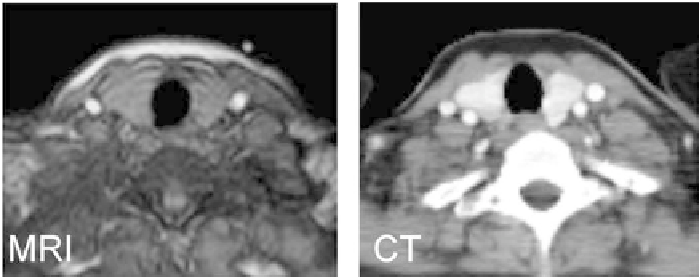Biomedical Engineering Reference
In-Depth Information
11.1 Introduction
Current concepts of combined PET/MR tomographs do not allow for sepa-
rate CT-like transmission sources. Therefore, corresponding PET attenuation
coecients must be calculated from the available MR images. MR-based atten-
uation correction (MR-AC) is far more challenging than the well-established
algorithms for CT-based attenuation correction (CT-AC) since MR image
voxel values correlate with the hydrogen nuclei density in tissues and tissue
relaxation properties rather than with electron density-related mass attenua-
tion coecients on CT (Figure 11.1). Therefore, a direct transformation from
available MR images to CT-like attenuation values is challenging [3].
Although pre-clinical PET/MR prototype systems [37] have been around
since the mid 1990s MR-AC is still a work in progress. While early pre-clinical
PET/MR design concepts did not include means for AC [17], [5] a relatively
simple 2-class attenuation correction scheme was suggested for the first clinical
prototype [36]. The lack of viable MR-AC methods today can be explained by
the fact that attenuation is less critical in small animals compared to pediatric
and adult patients, and, therefore, the issue of AC was of minor importance
in pre-clinical PET and PET/MR.
In this chapter we review methods to derive PET attenuation maps from
available MR images in clinical PET/MR imaging scenarios. We will discuss
potential pitfalls of MR-AC as well as a number of possible advantages of
MR-AC that in certain cases could render it beneficial over CT-AC.
Table 11.1 summarizes the main approaches to MR-AC for clinical imaging
scenarios. Interestingly, several studies of MR-AC appeared when such com-
FIGURE 11.1: Axial MR and CT images of the neck of the same patient
showing the differences in appearance of bone, air (trachea) and soft tissue.
The inability to segment bone structures based only on their MR intensity
renders simple scaling approaches to MR-AC impossible.









Search WWH ::

Custom Search